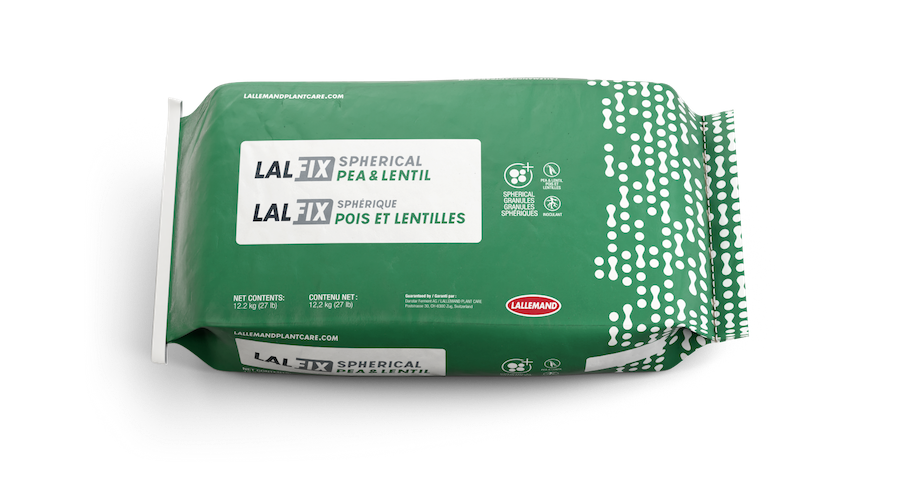In 2020, Robert Chenard of Falher, Alberta did a 60-acre trial with LALFIX® SPHERICAL Granular Inoculant on some virgin pea ground.
“I noticed better nodulation, standability and yield,” he said. “The LALFIX® SPHERICAL peas stood up a lot better and matured earlier with a higher yield. You could see a line in the field.”
These results — and the fact that almost all growers who try it, use it again — are due to the unique properties of this product, says Scott Gray, Commercial Manager, Canada at Lallemand Plant Care. LALFIX® SPHERICAL Granular was launched in 2020 in Canada and the U.S. by the Montreal-based family-owned company.
“The product is a brand-new dust-free granule with an extremely consistent granule size,” Gray said. “We see a lot of growers fighting with products that have dust, that don’t meter accurately and that often cause bridging. This product avoids all of that. It flows cleanly through the air seeder and applies evenly. There’s no downtime. It can be used in peas, lentils, and in soybeans.”
Gray says its reduced bulk density also provides significantly more coverage in the soil, with more granules per linear foot of row. This is important for close rhizobium to seed proximity in the soil.
Michael Cymbaliuk in Two Hills, Alberta also applied LALFIX® SPHERICAL in peas in 2020. “The application went really well for us,” he said. “It’s a nice solid product with very little dust. I’d compare it to canola. It’s pretty uniform in shape and size and metered out very well. The cleanout was very easy because there was no dust or anything to get hung up in the tank.”
Cymbaliuk says that overall, the product was also very easy to calibrate. “We noticed there were no lumps in the bag or tank if you rest it, whereas with some of the competitors you can get that if you leave it in the tank overnight.”
Rob Zerr of Langenburg, Saskatchewan, in his trial of the product in 2020 on peas, really liked the packaging size of less than 50 pounds.
“The bags were fairly light and the product itself was very uniform coming out of the bag,” he said. “What really impressed me was the flowability. We seeded about 20 acres and then the inoculant sat in the air seeder tank for four to five days until we were able to finish it off. When we went to use it again after those four to five days had passed, there was no moisture in the tank and it came out with no problems. There was no bridging.”
Unprecedented rhizobium survivability
Besides being designed for superior flowability, the innovative structure of the granules in LALFIX® SPHERICAL was designed to provide a highly protective micro-environment for the two entirely new rhizobium strains. This has a positive effect on bacterial survival, and in turn on root nodulation.
“Whether there are cold or dry conditions, the Rhizobium will thrive through that because of the protective honeycomb design of the granule,” Gray says. “As the plant roots grow, these two new strains of rhizobium colonize them early and aggressively. These strains have been shown in field after field to work in sync to promote very early nodulation and therefore fixing nitrogen earlier.”
In 2020, with a local retailer, Cymbaliuk pulled some pea plants to check the roots. “There were lots of nodules and it seems like they were spread throughout the entire root system, which is nice to see,” he said. “We cracked them open and they’re all pink inside, so they were definitely fixing nitrogen.”
Gray reports that this unique new carrier and honeycomb structure protects the rhizobium strains and increases survivability resulting in yield gains of up to 6% over competitor granular inoculants. These yield improvements have been witnessed in peas, lentils, and soybeans.
Trying new technology
Looking at his overall strategy with peas and more, Cymbaliuk explains that “we’ve been typically doing the same thing or something similar for years and years, so that’s why we try to keep a good crop rotation and have something different introduced into the soil. It’s always a plus, especially if it can give you a yield advantage.”
Zerr echoes these thoughts. “It’s important to embrace new technology because that’s the future. If you get stuck in one area or on something, you get left behind really quickly. There are always advances being made so it’s up to the producers to take advantage of that or not. I think it’s just good business to try to incorporate the newest and latest technology, as long as they’re affordable, into your farming practices.”
Indeed, Gray says Lallemand exists solely to create new science-backed microbial technologies to help its customers gain better performance.
Started in the late 1800s and headquartered in Montreal, it is owned and operated by the Chagnon family and currently led by Antoine Chagnon, marking the family’s third generation of proud ownership. The company has 11 global business units, with 4,500 employees in 45 countries, servicing customers in agriculture and many other sectors.
“Lallemand invests thousands of hours in its own lab and field research with more than 400 scientists worldwide, and also has many partnerships with researchers at major universities and research centres around the world,” Gray said. “It is all focused on understanding plant-microbe interactions and finding the most effective natural solutions. When you purchase a Lallemand product you are buying much more than high-performance biologicals, you are receiving science-backed, proven technologies.”










